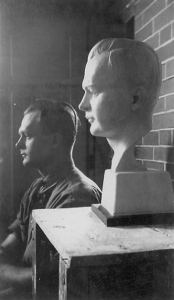

Biography
Bertrand Reuben Adams was born on Meadow View Farm, five miles south of Webster City, Iowa in 1907. His father raised Poland-China hogs and Percheron horses and assumed his son would take over the farm. But Bertrand became interested in art in high school, studying taxidermy with a local taxidermist. This led him to enroll in a correspondence course in commercial art from the Federal School of Commercial Designing in 1925. At that time the Federal School was the premier correspondence school nationally for the study of art. In 1928 Adams enrolled at the University of Iowa, majoring in art and economics. He graduated from the Federal School in 1932 and received his Bachelor of Fine Arts degree from the University of Iowa the same year. While at the University he met fellow artist Mary E. Beymer, whom he was to marry much later in life.
Adams was one of the artists chosen by Grant Wood to assist him with his murals at the Iowa State University Parks Library. Adams helped with the agricultural panel, including serving as a model for the veterinarian vaccinating a hog. He also did fine detail on the engineering panel, such as the surveyor's transit, bridge blueprint, hayfork and lettering.
In 1937, Adams's artwork was included in a show at the Whitney Museum in New York and a traveling exhibit in Iowa. He received commissions for two Post Office murals: "Early Settlers of Dubuque" (1937) in Dubuque, IA and "Lumbering in Arkansas" (1940) in Siloam Springs, AR.
Looking for some sort of financial stability, Adams sought work as an animator at the Walt Disney Studios. But his friends convinced him to make a major change, and he enrolled in the Still College of Osteopathy in Des Moines in 1940, receiving his license as an osteopath in 1943. He illustrated the osteopathic monograph Manual of Cranial Technique in 1943, interned at the Detroit Osteopathic Hospital in 1944 and opened a medical office in Ames, IA the same year.
From 1949-1958 he supervised the building of a house that he had designed, called the "Prairie Ark." This building has been compared with Frank Lloyd Wright's Usonian houses, and, although the work of an amateur, contained many innovative features, notably its use of passive solar elements. Ever the artist, Adams decorated the garage door of the Prairie Ark with a bold geometric design. He and Mary Beymer finally married in Des Moines in 1956. Adams continued his osteopathic practice until 1991 and died in Ames in 1994.


Critical Analysis
Both of Adams's Post Office murals display bold and engaging designs. His Dubuque mural is interesting in the way it fills a rather awkward space. Adams's mural and a mural by William E.L. Bunn are situated in an outer lobby with an extremely high ceiling, creating a tall, narrow space for the artworks. Adams dealt with this problem by incorporating several architectural elements with extreme verticality. In the foreground on the right, there is the Dubuque Shot Tower (1856), while the background includes the Julien Dubuque Tower on a hill to the left. The central foreground features a covered wagon. Everything is cleverly set beneath the span of a very high bridge, inviting the viewer to look upwards at the painting - a necessity for anyone to see it.
Beyond Adams's artistic ability, the most impressive thing about him was his vast array of interests. His approach to medicine was very open-minded: he could be viewed as a "wellness" pioneer with his emphasis on diet, exercise, nutrition and organic food; or he could be viewed as a fringe figure with his classes in astrology and his studies of auras, psychic phenomena and phrenology. Beyond medicine, he was an amateur astronomer, hosting stargazing events of the Ames Area Amateur Astronomers at his backyard telescope. The club's current observatory is named in Adams's honor.
Murals
- Siloam Springs, Arkansas - Former Post Office: Lumbering in Arkansas
- Dubuque, Iowa - Post Office: Early Settlers of Dubuque
References
- Frederick J. Kiesler, The Architect in Search Of ..., Achitectural Record February (1937).
- Bert Adams and His Garage Door (Ames History Museum).
- Bertrand Adams Family (Ames Historical Society).
- Bertrand and Mary Adams (Ames History Museum).
- Biography of Bertrand R. Adams (Artprice).
- Happy Birthday, AAAA! (Cosmic Reflections).